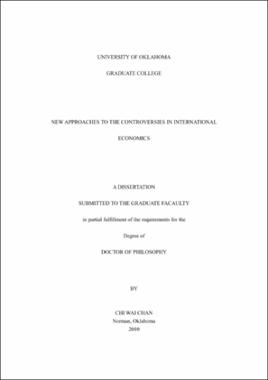| dc.contributor.advisor | Grier, Kevin | |
| dc.creator | Chan, Chi Wai | |
| dc.date.accessioned | 2019-04-27T21:39:14Z | |
| dc.date.available | 2019-04-27T21:39:14Z | |
| dc.date.issued | 2010 | |
| dc.identifier | 9961389702042 | |
| dc.identifier.uri | https://hdl.handle.net/11244/319279 | |
| dc.description.abstract | This dissertation examines the validity of the Fisher hypothesis and the Balassa-Samuelson hypothesis by using an approach which is different from those employed in the previous studies. The importance of the hypotheses in the field of international economics is reflected by the ample volume of research work directed to them. Nevertheless, the validity of the hypotheses remains controversial and the findings on the issues are diverse. In light of this, I use a different empirical approach to examine the two hypotheses and hope that the findings here would bring new insight to the literature. | |
| dc.description.abstract | In the first chapter of my dissertation, I investigate whether the Fisher effect holds for the US. The Fisher relationship maintains that nominal interest rates and expected inflation move in a one-to-one manner. As conventional unit root tests find that both nominal interest rates and inflation are unit root processes, most recent papers have used a cointegration approach to verify if the fisher effect holds. Given that US nominal interest rates and inflation fell and rose after reaching certain peaks and troughs over the last few decades, there is doubt in treating the time series as non-stationary. I investigate the issue for the US using two different approaches. In the structural break analysis, I find that the direction and magnitude of breaks in nominal interest rate and inflation follow approximately to what the Fisher effect predicts. The stability of real interest rates provides further support for the validity of the Fisher link. In the second part of the paper, I use a VAR model to examine the dynamic relationship between nominal rates and inflation. As volatility clustering is present, I include a GARCH effect in the estimation. The results show that nominal rates respond positively to a shock in inflation and the magnitude of cumulated response is only slightly below that predicted by the Fisher hypothesis. The findings are strongly in favor of the presence of the Fisher effect. | |
| dc.description.abstract | The second chapter examines validity of the Balassa-Samuelson hypothesis (BSH) in a sample of nine OECD countries with the US taken as the benchmark. The BSH admits the importance of productivity in explaining the fluctuations of real exchange rates via its impact on the relative non-tradable prices. The results from the structural break analysis indicate that four countries tie with the hypothesis while the other three countries are in partial fit. Similar findings are obtained when government spending is considered in the estimations. Examining the dynamic relationship among the variables by a VAR-GARCH model, the findings support a strong link between productivity shocks and real exchange rates. The results are robust when the time series are either treated as I(0) or I(1). The responses of relative prices to productivity shocks are in the expected directions, however, the sizes are mild in most cases. In this regard, I examine an alternative transmission channel for productivity shocks. The results suggest that the real exchange rate of tradable goods maybe an important channel through which productivity impacts on real exchange rates. As a whole, the findings in this paper are slightly in favor of the hypothesis. | |
| dc.description.abstract | In the third chapter, I extend my study on the Fisher hypothesis to cover the same sample of nine OECD countries. I employ a similar empirical approach as in the first chapter. In the structural break analyses, I investigate if real interest rates are stable over the entire sample period. Since the findings show that the real rates for most of these countries have experienced major shifts over time, I examine the reasons behind these changes by considering some possible factors suggested by the literature. Employing VAR-GARCH models and innovation analyses, I find that nominal interest rates have limited response to inflation shock. The failure of achieving the hypothesized one-to-one relationship is not due to an inappropriate tax adjustment of the nominal rates. After considering the overall results, only two countries in the sample follow closely with the predictions from the Fisher hypothesis. While the evidence of three countries rejects the Fisherian link, the findings for the rest are mixed. I suggest that the evidence for the Fisher hypothesis is weak. | |
| dc.format.extent | 197 pages | |
| dc.format.medium | application.pdf | |
| dc.language | en_US | |
| dc.relation.requires | Adobe Acrobat Reader | |
| dc.subject | Fisher effect (Economics) | |
| dc.subject | Interest rates--Effect of inflation | |
| dc.subject | Foreign exchange rates | |
| dc.title | New Approaches to the Controversies in International Economics | |
| dc.type | text | |
| dc.type | document | |
| dc.thesis.degree | Ph.D. | |
| ou.group | College of Arts and Sciences::Department of Economics | |
